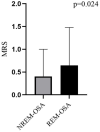Differential analysis of clinical outcomes in cerebral infarction associated with REM-OSA and NREM-OSA: a retrospective database study
- PMID: 40734824
- PMCID: PMC12305585
- DOI: 10.3389/fneur.2025.1607963
Differential analysis of clinical outcomes in cerebral infarction associated with REM-OSA and NREM-OSA: a retrospective database study
Abstract
Background: Obstructive sleep apnea (OSA) is one of the factors that affect the prognosis of cerebral infarction. Rapid eye movement-related obstructive sleep apnea (REM-OSA) has been confirmed as an important clinical subtype of OSA, yet it is frequently overlooked in clinical practice. REM-OSA is an important but underrecognized clinical issue in the study of improving the prognosis of cerebral infarction.
Objective: To investigate the relationships among REM-OSA and cerebral infarction clinical prognosis.
Methods: In this retrospective cohort study, 318 cerebral infarction patients with OSA (AHI ≥ 5) were enrolled from February 2022 to January 2025 at the Department of Neurology, Affiliated Hospital of Yangzhou University. Participants were stratified into REM-OSA (n = 71) and NREM-OSA (n = 247) groups using stringent criteria (AHIREM/AHINREM ≥ 2, REM duration ≥30 min). Data included polysomnography, neurological assessments (NIHSS, MRS), inflammatory markers (WBC, hs-CRP), and neuroimaging. Statistical analyses comprised logistic regression and Pearson correlation tests.
Results: Compared to NREM-OSA, REM-OSA patients exhibited: (1) Poorer prognosis: Higher 3-month mRS scores (OR = 1.543, p = 0.032), independent of total AHI. (2) Enhanced inflammation: Elevated WBC (7.45 vs. 6.50 × 109/L, p = 0.011) and hs-CRP (3.95vs.1.16 mg/L, p < 0.001), correlating with AHIREM (r = 0.234-0.268, p < 0.001). (3) Unique neuroanatomical vulnerability: Higher basal ganglia infarction prevalence (83.1% vs. 64.8%, p = 0.003; OR = 2.359). (4) Severe REM-specific hypoxia: Lower minimum SpO₂ (81.62% vs. 84.31%, p < 0.001) and prolonged apneas. (5) Sleep architecture disruption: Reduced sleep efficiency and prolonged latency (PSQI: 10.18 vs. 8.52, p = 0.004). (6) Age inversely correlated with REM-OSA severity (r = -0.154, p = 0.020).
Conclusion: REM-OSA is independently associated with poorer prognosis in cerebral infarction patients. Potential explanatory mechanisms include REM-specific hypoxia, systemic inflammation, and basal ganglia vulnerability.
Keywords: basal ganglia; cerebral infarction; hypoxia; inflammation; obstructive sleep apnea; prognosis; rapid eye movement phase.
Copyright © 2025 Xu, Yu, Sun, Zheng, Jing, Xu, Tang and Chu.
Conflict of interest statement
The authors declare that the research was conducted in the absence of any commercial or financial relationships that could be construed as a potential conflict of interest.
Figures



Similar articles
-
Rapid eye movement (REM)-related obstructive sleep apnea and hypertension: insights from the clinical spectrum of apnea-hypopnea index ratios across REM and non-REM sleep stages in a Chinese cohort.J Sleep Res. 2025 Aug;34(4):e14418. doi: 10.1111/jsr.14418. Epub 2024 Nov 27. J Sleep Res. 2025. PMID: 39604302
-
Effects of opioid, hypnotic and sedating medications on sleep-disordered breathing in adults with obstructive sleep apnoea.Cochrane Database Syst Rev. 2015 Jul 14;(7):CD011090. doi: 10.1002/14651858.CD011090.pub2. Cochrane Database Syst Rev. 2015. PMID: 26171909
-
Older adults at greater risk for Alzheimer's disease show stronger associations between sleep apnea severity in REM sleep and verbal memory.Alzheimers Res Ther. 2024 May 9;16(1):102. doi: 10.1186/s13195-024-01446-3. Alzheimers Res Ther. 2024. PMID: 38725033 Free PMC article.
-
Drug therapy for obstructive sleep apnoea in adults.Cochrane Database Syst Rev. 2013 May 31;2013(5):CD003002. doi: 10.1002/14651858.CD003002.pub3. Cochrane Database Syst Rev. 2013. PMID: 23728641 Free PMC article.
-
Drug therapy for obstructive sleep apnoea in adults.Cochrane Database Syst Rev. 2006 Apr 19;(2):CD003002. doi: 10.1002/14651858.CD003002.pub2. Cochrane Database Syst Rev. 2006. Update in: Cochrane Database Syst Rev. 2013 May 31;(5):CD003002. doi: 10.1002/14651858.CD003002.pub3. PMID: 16625567 Updated.
References
-
- Conwell W, Patel B, Doeing D, Pamidi S, Knutson KL, Ghods F, et al. Prevalence, clinical features, and CPAP adherence in REM-related sleep-disordered breathing: a cross-sectional analysis of a large clinical population. Sleep Breat. (2012) 16:519–26. doi: 10.1007/s11325-011-0537-6, PMID: - DOI - PubMed
LinkOut - more resources
Full Text Sources
Research Materials
Miscellaneous

